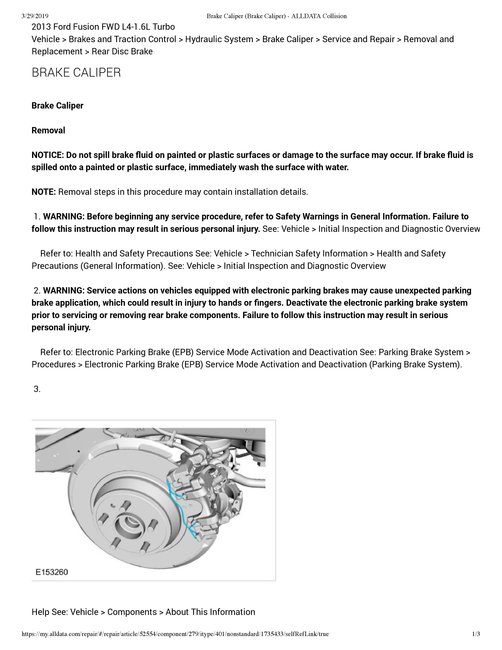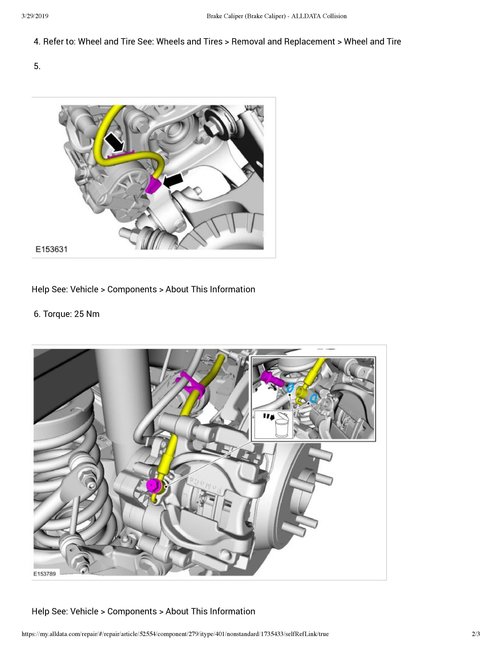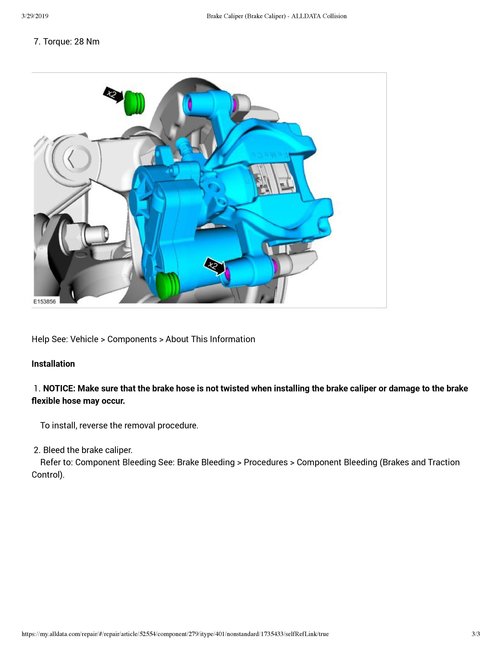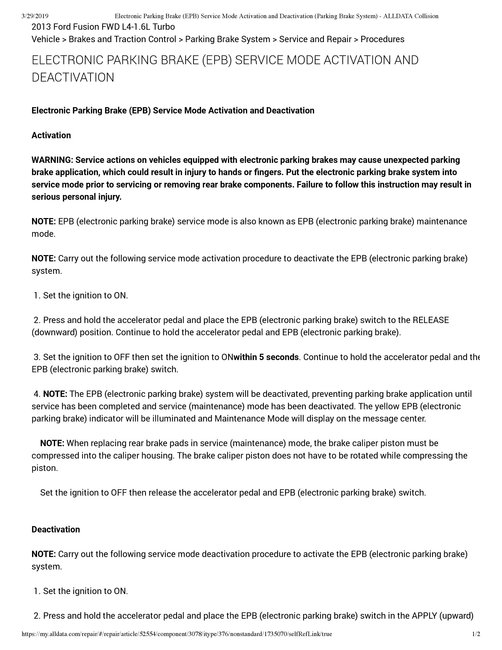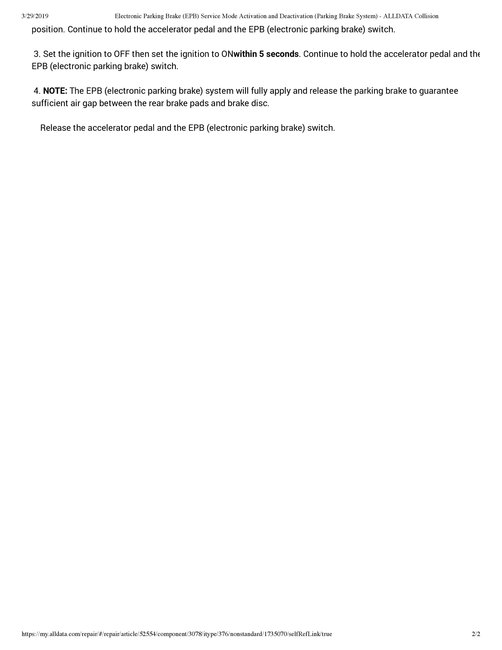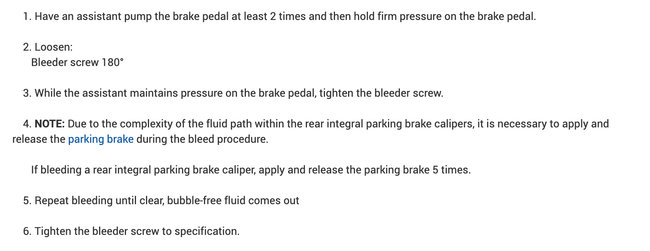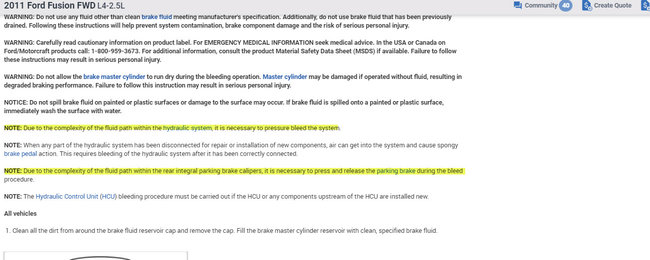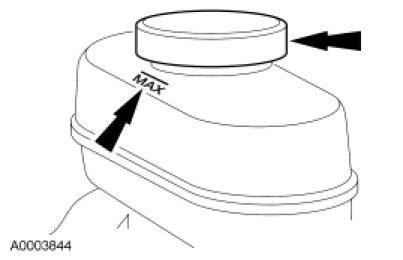Welcome to 2CarPros.
Due to the complexity of the fluid path within the hydraulic system, it is necessary to pressure bleed the system. To make things worse, it requires specific software. Here are the directions:
________________________
2010 Ford Fusion FWD L4-2.5L
Brake System Bleeding
Vehicle Brakes and Traction Control Hydraulic System Brake Bleeding Service and Repair Procedures Brake System Bleeding
BRAKE SYSTEM BLEEDING
Brake System Bleeding
picture 1
picture 2
Pressure Bleeding
WARNING: Do not use any fluid other than clean brake fluid meeting manufacturer's specification. Additionally, do not use brake fluid that has been previously drained. Following these instructions will help prevent system contamination, brake component damage and the risk of serious personal injury.
WARNING: Carefully read cautionary information on product label. For EMERGENCY MEDICAL INFORMATION seek medical advice. In the USA or Canada on Ford/Motorcraft products call: 1-800-959-3673. For additional information, consult the product Material Safety Data Sheet (MSDS) if available. Failure to follow these instructions may result in serious personal injury.
WARNING: Do not allow the brake master cylinder to run dry during the bleeding operation. Master cylinder may be damaged if operated without fluid, resulting in degraded braking performance. Failure to follow this instruction may result in serious personal injury.
NOTICE: Do not spill brake fluid on painted or plastic surfaces or damage to the surface may occur. If brake fluid is spilled onto a painted or plastic surface, immediately wash the surface with water.
NOTE: When any part of the hydraulic system has been disconnected for repair or installation of new components, air can get into the system and cause spongy brake pedal action. This requires bleeding of the hydraulic system after it has been correctly connected.
NOTE: Due to the complexity of the fluid path within the rear integral parking brake calipers, it is necessary to press and release the parking brake during the bleed procedure.
NOTE: The Hydraulic Control Unit (HCU) bleeding procedure must be carried out if the HCU or any components upstream of the HCU are installed new.
All vehicles
1. Clean all the dirt from around the brake fluid reservoir cap and remove the cap. Fill the brake master cylinder reservoir with clean, specified brake fluid.
Pic 3
2. NOTE: Master cylinder pressure bleeder adapter tools are available from various manufacturers of pressure bleeding equipment. Follow the instructions of the manufacturer when installing the adapter.
Install the bleeder adapter to the brake master cylinder reservoir and attach the bleeder tank hose to the fitting on the adapter.
3. NOTE: Make sure the bleeder tank contains enough specified brake fluid to complete the bleeding operation.
Open the valve on the bleeder tank.
- Apply 207-345 kPa (30-50 psi) to the brake system.
4. Remove the RH rear bleeder cap and place a box-end wrench on the bleeder screw. Attach a rubber drain tube to the RH rear bleeder screw and submerge the free end of the tube in a container partially filled with clean, specified brake fluid.
5. Loosen the RH rear bleeder screw. Leave open until clear, bubble-free brake fluid flows, then tighten the RH rear bleeder screw.
- Press and release the parking brake 5 times.
- Repeat until clear, bubble-free fluid comes out.
6. Tighten the RH rear bleeder screw to specifications, refer to Specifications. Remove the rubber hose and install the bleeder screw cap.
7. Repeat Steps 4 through 6 for the LH rear brake caliper.
8. Remove the RH front bleeder cap and place a box-end wrench on the bleeder screw. Attach a rubber drain tube to the RH front bleeder screw and submerge the free end of the tube in a container partially filled with clean, specified brake fluid.
9. Loosen the RH front bleeder screw. Leave open until clear, bubble-free brake fluid flows, then tighten the RH front bleeder screw.
10. Tighten the LH rear bleeder screw to specifications, refer to Specifications. Remove the rubber hose and install the bleeder screw cap.
11. Repeat Steps 8 through 10 for the LH front brake caliper.
12. Close the bleeder tank valve and release the pressure. Remove the tank hose from the adapter and remove the adapter. Fill the reservoir with clean, specified brake fluid and install the reservoir cap.
Hybrid vehicles
13. NOTE: On hybrid vehicles, the brake booster push rod has an elongated slot that attaches to the brake pedal with a clevis pin. The elongated slot allows for a small amount of pedal travel (free play) to occur without the brake pedal applying pressure on the booster push rod. When performing a bleed procedure, it is important to push the pedal through the air gap, so that the clevis pin is contacting the brake booster push rod. Except when required by the scan tool, the ignition key must remain off during the bleed procedure to allow minimal force required to push through the gap.
With the ignition off, press the brake pedal through the gap to seat the clevis pin against the brake booster push rod and then confirm the pedal is firm.
- If the brake pedal is spongy (soft), repeat the Pressure Bleeding procedure to remove any remaining air from the system.
Non-hybrid vehicles
14. Apply the brakes several times to verify correct brake operation.
- If the brake pedal is spongy (soft), repeat the Pressure Bleeding procedure to remove any remaining air from the system.
Hydraulic Control Unit (HCU) Bleeding
WARNING: Do not use any fluid other than clean brake fluid meeting manufacturer's specification. Additionally, do not use brake fluid that has been previously drained. Following these instructions will help prevent system contamination, brake component damage and the risk of serious personal injury.
WARNING: Carefully read cautionary information on product label. For EMERGENCY MEDICAL INFORMATION seek medical advice. In the USA or Canada on Ford/Motorcraft products call: 1-800-959-3673. For additional information, consult the product Material Safety Data Sheet (MSDS) if available. Failure to follow these instructions may result in serious personal injury.
WARNING: Do not allow the brake master cylinder to run dry during the bleeding operation. Master cylinder may be damaged if operated without fluid, resulting in degraded braking performance. Failure to follow this instruction may result in serious personal injury.
NOTICE: Do not spill brake fluid on painted or plastic surfaces or damage to the surface may occur. If brake fluid is spilled onto a painted or plastic surface, immediately wash the surface with water.
NOTE: When any part of the hydraulic system is disconnected for repair or installation of new components, air can get into the system and cause spongy brake pedal action. This requires bleeding of the hydraulic system after it is correctly connected.
All vehicles
1. Use the Pressure Bleeding procedure to bleed the system. For additional information, refer to Brake System Bleeding.
2. Connect the scan tool and follow the ABS HCU Hydraulic Control Unit (HCU) bleeding instructions.
3. Repeat the Pressure Bleeding procedure to bleed the system.
Hybrid vehicles
4. Following the scan tool instructions, carry out the Multi-Calibration Routine.
___________________________
Let me know if I can help in any way.
Joe
Images (Click to make bigger)
Friday, April 9th, 2021 AT 2:08 PM
(Merged)
